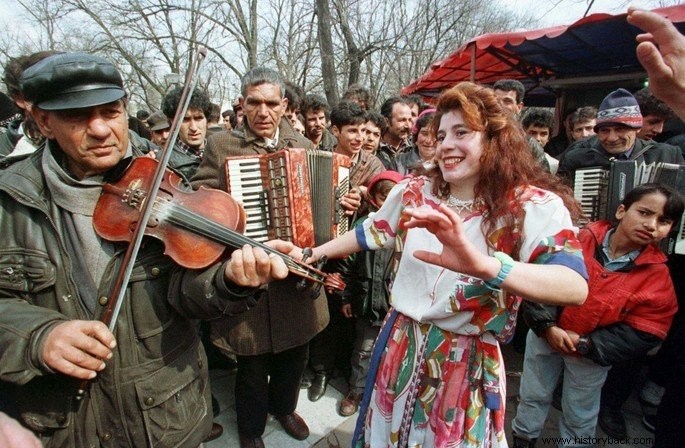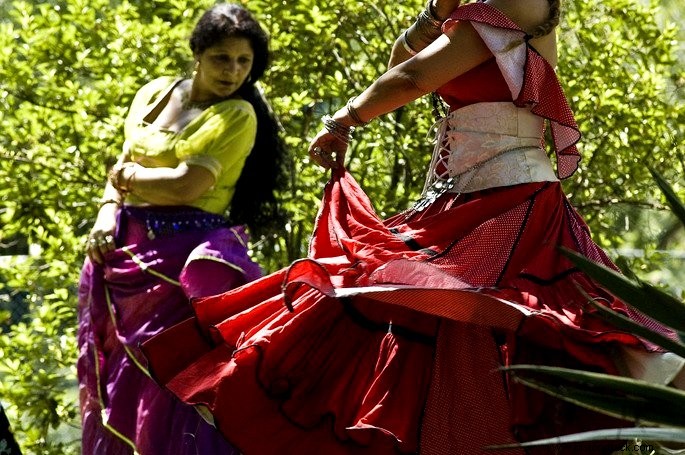We understand by gypsies a group of people who are nomads, divided into clans that roamed Europe. Gypsies are far from constituting a single and homogeneous people, and are divided into several ethnic groups.
They are also known as “Romi” and throughout Western history they were marginalized because of their way of life, considered incompatible with European society.
Origin of the Gypsy people
As Gypsies do not have a written language, their entire history was written by non-Gypsies. Therefore, testimonies are not always free from prejudice.
One of the big questions is to know the place of origin of the gypsies. Currently, India, especially the Punjab region, is considered to be the most likely homeland. From there they would have passed to Egypt, and from there to the European continent.
The first document that attests to the presence of gypsies in Spain is from 1423, when they ask permission to cross the territory in order to make a pilgrimage to Santiago de Compostela.

Where do gypsies live?
The countries where the largest number of Roma live are the United States (1,000,000), Brazil (800,000) and Spain (710,000).
However, it is in countries like Serbia, Bulgaria, Slovenia and Romania that the highest proportion of Roma in the population is found.
Gypsy people in Brazil
The gypsies arrived in Brazil with the Portuguese navigators. The Portuguese authorities saw in their overseas territories an opportunity to get rid of these individuals who were considered “unwanted”.
Gypsies settled in practically the entire national territory, especially in Bahia.
Currently, there are three major gypsy groups in the country. The first, from Portugal and Spain, which maintains the Caló dialect. The second, the Rom, which uses Romani, and are mainly from Eastern Europe. Finally, the Sintis, from Germany and France, after the First World War (1914-1918).
According to IBGE data, in 2010 there were about 800 thousand gypsies in Brazil. Most no longer live as nomads and are fixed in one region.
Gypsy culture

Because they were nomads, the gypsies were incorporating habits and customs of the regions where they were. However, it is possible to identify common traits that make up the gypsy culture.
Gypsies ended up exercising trades that could be performed everywhere. That's why men were blacksmiths, traders, horse and cattle keepers.
Within the gypsy clans, women are more restricted to the domestic sphere, but they performed work as seamstresses, lacemakers and artists. They also dedicated themselves to reading hands and cards to predict the future.
Values such as fidelity to family and clan, and intermarriage are other outstanding characteristics that we can observe in all gypsies.
Romani - Gypsy language
Gypsies developed the Romani language, also called Romanese.
It is an unwritten language (not written) and taught orally by Roma families. There are ethnicities that speak it with ease, but others only know a few words.
Likewise, it is forbidden for non-Gypsies to learn this language. However, with globalization and the internet, this barrier begins to break down.
Gypsy religion
It is important to emphasize that Gypsies do not have a religion in the strict sense of the term. They have a set of beliefs and principles, but there is no figure of a god (or gods) in concrete, nor a religious hierarchy.
Gypsies adopted the religion of the territory through which they circulated. In this way we find Catholic, Orthodox, Evangelical, Spiritualist and Muslim Gypsies.
Among gypsy Catholics there is great devotion around Santa Sara de Kali, who would have been supported by gypsies in the south of France.
In Umbanda religion, there are "gypsy entities" that would be the spirits of deceased gypsies.
Gypsy Dance
Gypsy dance is the result of a mixture of several elements, but it was in Spain that it gained strength.
Gypsies danced in their camps, at parties, accompanied by musical instruments, singing and clapping. Both women and men danced in the middle of the circle.
In this way, gypsy dance is sensual, strong and quite expressive, as the whole body participates in the movements. Among women there is the custom of dancing barefoot, with long skirts and richly decorated with jewels.
Among all the elements of gypsy culture, flamenco is the one with the greatest expression worldwide.
Prejudice against Gypsies
Gypsies have always been the target of prejudice in Europe and this behavior has spread to the Americas.
One of the reasons they were always frowned upon was their lifestyle. They were nomads, in a sedentary society; they had no written laws, at a time when everyone had them. Likewise, despite accepting Christianity, they practiced certain practices condemned by the Church as fortune-telling.
Thus, all kinds of stories emerged about these people classifying them as cheaters and thieves, as if these attitudes were exclusive to gypsies.
Gypsy stereotypes
In the same way that there are stereotypes for Northeasterners, blacks, Jews, fat people and anyone who doesn't fit a certain standard, there are a multitude of preconceived ideas against gypsies.
One of the most common is that gypsies stole children and there are numerous legends of babies who disappeared after a gypsy group passed through a city. We have to consider, however, that all marginalized people were accused of this crime.
Another very common accusation was that Gypsies stole and lied. This is true when a Gypsy is in a relationship with a non-Gypsy. However, among them, there are strict honor codes that prevent dishonesty among them.
We see that these attitudes were used in order to protect themselves against external attacks and not a characteristic that was born with this people.
Persecution of Gypsies
Gypsies were persecuted during the formation of National Monarchies in Europe, as anyone who was not Catholic was expelled. This measure affected Jews and Muslims alike.
During World War II (1939-1845), Gypsies were persecuted and confined in Nazi concentration camps. An estimated 250,000 Roma were killed in this period, especially in Croatia, where the population was nearly wiped out.
Don't stop here. There are more texts that are very useful for you :
- Prejudice
- What is culture?
- Holocaust
